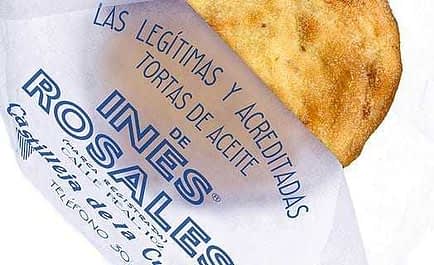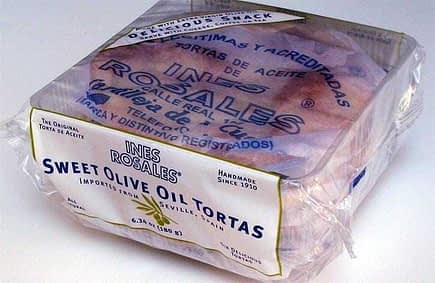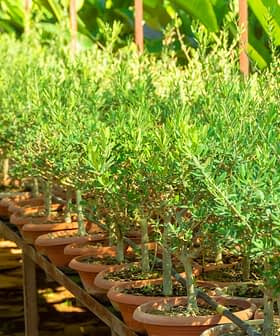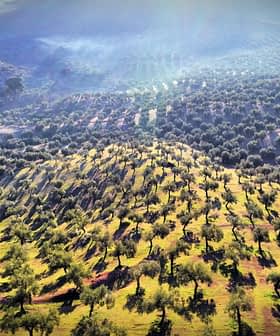Extra virgin olive oil is the only preservative in — and forms a quarter of — Spain’s widely exported pastry Torta de Aceite de Castilleja de la Cuesta.
These olive oil tortas — some call them biscuits, sweet flatbreads or wafers — have gone from a home-made pastry eaten in Seville at Easter to sales of about 130 million units a year and across five continents by the Ines Rosales company alone.
There are now various versions on the market but the story goes that the traditional ones made by Ines Rosales derive from the woman of the same name, who in the village of Castilleja de la Cuesta in the early 1900s took an old family recipe and, with the help of local women, started selling the tortas at a train station and major crossroads.
The recipe is said to remain much the same and — apart from being 27.7 percent EVOO — the ingredients include flour, sugar, yeast, sesame, aniseed, and anise essence.
Today, a 180g (6.3oz) packet of six sells in Spanish department store El Corte Inglés for €1.40 € ($1.80) and, according to Ines Rosales export manager Antonio Boza, retails for about $4.99 in the US, £2.99 in England and €2.50-€3.00 in Germany and France.
An application is currently before the European Commission to list ‘Tortas de Aceite de Castilleja de la Cuesta’ as one of Europe’s “traditional specialities guaranteed” (TSG) products, part of a scheme to promote and protect the names of quality agricultural products.
From Seville, Ines Rosales export manager Antonio Boza spoke to Olive Oil Times about the EVOO used in the product and why the TSG recognition is sought.
What kind of EVOO do you use in the tortas?
The most important thing is to maintain consistency in the qualities of the product over time. Because we seek a balance between product stability and the flavor expected by our consumers, we use a mix of olive oil varieties to achieve that.
Our EVOO must be fairly mild-tasting and have considerable oxidative stability as it is the only preservative in our tortas and forms nearly a quarter of the final product.
Each master miller knows which of their EVOOs would meet our needs and often olive oil mills have to find several varieties in order to meet our specifications.
Every 20 days we repeat the purchase process and each batch is submitted to a protocol including sending of a sample, a panel test, and other verification that standards are met, including our requirement that the oil not be spicy or bitter.
You have to analyze every tankload because you can’t assume that a sting in the throat or bright green color guarantees quality.

How are your tortas eaten?
Their traditional consumption in Spain was with coffee or tea for breakfast, as a snack anytime, or with a dessert such as crema catalana. But interestingly our export markets are teaching us new ways of using them. They are much more versatile than we had realized!
Some people now combine the sweet tortas with ice cream or yogurt, or with a fortified wine for dessert, or as the base for canapés with cheeses and marmalades.
The savory ones are used as an accompaniment to cheeses, pâté, and smoked goods, or as an appetizer with a beer, wine or gin and tonic.
Why did the Ines Rosales company apply to register‘Tortas de Aceite de Castilleja de la Cuesta’ as a traditional specialty in Europe?
We see it as recognition of the unique quality and origin of a product that this company pioneered and is the leading representative of nationally and internationally.
It’s also an asset for marketing and provides recognition for companies that make products according to traditional, hand-made methods, and with extra virgin olive oil, differentiating us from those making a lower quality product that does not meet the EU standards.

There’s a big variety of products under the umbrella of ‘Torta de Aceite’ that are all very different and this makes it hard for consumers to distinguish between them, especially when bought outside their area of origin.
Castilleja de la Cuesta is the original village which used a distinct production method and furthermore its tortas de aceite are the ones that have had the biggest global reach.
It will be another mark of differentiation for us and therefore help in marketing, and no doubt we’ll be the first to hold that distinction.
For those who have yet to try it, the distinction might encourage them to do so by certifying the authenticity of its origin, traditional production method and use of natural ingredients.
A scan of the internet suggests tourists often buy these tortas in Spain then try to track them down again in their home country. How much of your output goes abroad?
We export 20 percent of our production and our main export market is the USA but we have a presence on five continents thanks to exports to Canada, Mexico, the UK, France, Germany, Switzerland, South Africa, Australia, New Zealand, Japan, China and the United Arab Emirates.









